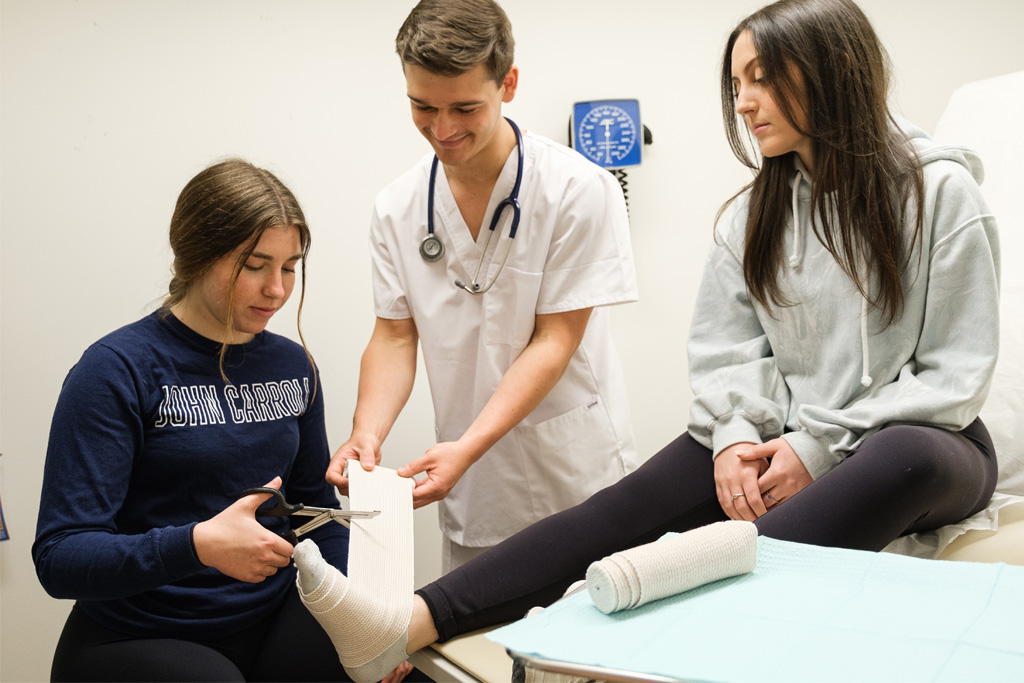How to Prepare for a BSN Program: Know Your Key Competencies, Concepts and Learning Styles

If you tell someone that you’re pursuing a professional health degree (medicine, pharmacy, physical therapy, veterinary or nursing), they might warn that it’s “like drinking from a fire hydrant.”
We all know that trying to download and commit to memory every bit of basic science and practice knowledge required for graduation can be challenging. We also know that nurse education is changing.
The faculty and curriculum leaders who designed the BSN degree offered by John Carroll University encourage all nursing students to arrive with three basic insights and strategies:
- competency-based education
- essential nursing domains/concepts
- learning styles
Competency-Based Education
Familiarize yourself with the competency-based education, which stresses the importance of specific skills and clinical judgment that translate easily and directly from the college environment to the bedside. Advances in simulation manikins and labs allow faculty to contextualize new nursing knowledge within an experiential learning environment that mirrors real-world practice settings.
Competency-based education values the outputs of an educational experience versus the inputs of the educational environment and system. Rather than faced with the proverbial fire hydrant of reading, you are invited onto the stage of an experiential learning environment where your knowledge, emotions, communication skills and more are revealed, supported and honed.
Essential Nursing Domains/Concepts
Scan the American Association of Colleges of Nursing’s Essentials Series, which introduces 10 domains and eight core concepts with associated sub-competencies within each of the domains that represent the essence of professional nursing practice.
The eight core concepts are:
Clinical Judgment
Your ability to interpret information and reason in the delivery of care.
Communication
Your command of tools (voice, writing, behavior, body language, emotion) and drivers (intention, motive, partnership, trust, and presence) to manage yourself and others within teams and across professions.
Compassion
Your recognition that humans are meaning-making beings, and that compassionate care hinges on some measure of relating to others as fellow, flawed human beings.
Diversity, Equity, and Inclusion
Your ability to see beyond the buzzword phrase, and recognize that a person’s birth, origin and experience exerts an influence on everything — from financial resources to emotional resilience — that show up in your encounter with a person trying to heal and recover.
Ethics
Your grasp of a vast and growing set of nuanced questions and conversations around what it means to do the right thing, medically, legally and morally.
Evidence-Based Practice
Your capacity to investigate current evidence and clinical expertise, and reconcile data and science with individual and family preferences.
Health Policy
Your ability to widen the perspective of what makes for good nursing from the intense focus of the bedside and a broader view of how policy impacts nursing practice and patient outcomes.
Social Determinants of Health Determinants
Your facility to see beyond the electronic health record and appreciate that the soil of someone’s birth and beginnings (personal, social, economic, and environmental) exert a sustained impact on health.
Individual Learning Styles
Within nursing education and practice settings, leaders may encourage you to get to know your individual learning style. While there are many models for individual learning style differences, the following offers some basic types and tendencies.
Sensing Learner
You tend to be a practical, concrete thinker typically oriented toward facts and procedures.
Intuitive Learner
You tend to be an abstract thinker, energized by alternative approaches and innovations, and oriented toward theories and underlying meanings.
Visual Learner
You tend to prefer visual representations of presented material such as pictures, diagrams, and flow charts.
Verbal Learner
You tend to prefer written and spoken explanations, and will likely read body language and cues.
Active Learner
You tend to gravitate toward group settings and consensus-based solutions. You enjoy the iterative process, and learn by trying ideas and solutions out until one rises.
Reflective Learner
You tend to work best alone or with a single, familiar partner. You work through problems in an orderly, sequential process.
BSN Difference
The BSN degree offered by John Carroll University supports diverse learning styles, and produces nurse professionals who are comfortable with the complexity of modern nursing and health care.
